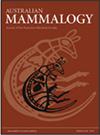黄腹滑翔机采食树液和树体试验的变化及其种群监测的潜力
IF 1.2
4区 生物学
Q3 ZOOLOGY
引用次数: 0
摘要
树液是黄腹滑翔机(Petaurus australis)的重要食物。我在新南威尔士州肖尔黑文地区进行了为期两年的八次调查,调查了32个地点(相当于32个滑翔机群体)滑翔机对66棵树的汁液取食情况,以评估在种群监测中使用这些树木的潜力。我估计了在0-3个月的调查中,在树液树上发现两种不同类型的滑梯切口的概率:一种代表了树液的取食,另一种代表了这些树是否适合取食。各类型切口的检出率随季节变化,秋季最低,春季最高(喂饲:0.30±0.03 (s.e) ~ 0.51±0.04;试验范围:0.40±0.04 ~ 0.63±0.03)。我还调查了在一个地点的单个树液中是否检测到任何新的切口。每次调查的检出率在树木和年份之间是相等的(0.76±0.03)。这些切口会累积一年以上,因此对上次年度调查以来所做的任何切口进行评分都会增加这种可能性。在两个样本年的每一年,在所有地点都发现了新的切口,表明家庭范围占用的短期稳定性,并展示了一种有用的种群监测方法。本文章由计算机程序翻译,如有差异,请以英文原文为准。
Variation in sap feeding and tree testing by yellow-bellied gliders and the potential for population monitoring
Tree sap is important in the diet of the yellow-bellied glider (Petaurus australis). I investigated the use of 66 trees in sap feeding by gliders at 32 sites (equating to 32 glider groups) in eight surveys over 2 years in the Shoalhaven region of New South Wales to evaluate the potential to use such trees in population monitoring. I estimated the probability of detecting two different types of glider incision made on the sap trees within 0–3 months of a survey: one representing bouts of sap feeding and the other representing the testing of the suitability of these trees for sap feeding. The probability of detecting each type of incision varied by season, being lowest in autumn and highest in spring (feeding: 0.30 ± 0.03 (s.e.) to 0.51 ± 0.04; testing: 0.40 ± 0.04 to 0.63 ± 0.03). I also investigated whether detection of any new incision differed between individual sap trees at a site. The probability of detection per survey was equivalent (0.76 ± 0.03) between trees and between years. The incisions accumulate over a year, so scoring any incisions made since a previous annual survey will increase this probability. New incisions were detected in each of the two sample years at all sites indicating short-term stability in home range occupancy and demonstrating a useful method of population monitoring.
求助全文
通过发布文献求助,成功后即可免费获取论文全文。
去求助
来源期刊

Australian Mammalogy
ZOOLOGY-
CiteScore
2.50
自引率
8.30%
发文量
26
期刊介绍:
Australian Mammalogy is a major journal for the publication of research in all branches of mammalogy. The journal’s emphasis is on studies relating to Australasian mammals, both native and introduced, and includes marine mammals in the Antarctic region. Subject areas include, but are not limited to: anatomy, behaviour, developmental biology, ecology, evolution, genetics, molecular biology, parasites and diseases of mammals, physiology, reproductive biology, systematics and taxonomy.
Australian Mammalogy is for professional mammalogists, research scientists, resource managers, consulting ecologists, students and amateurs interested in any aspects of the biology and management of mammals.
Australian Mammalogy began publication in 1972 and is published on behalf of the Australian Mammal Society.
 求助内容:
求助内容: 应助结果提醒方式:
应助结果提醒方式:


